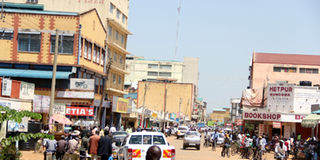Bungoma is an attractive market for agriculture and industry

A busy day in Bungoma town. Residents of Kibabii in Bungoma County have started reaping the fruits of having a university in their region. FILE PHOTO | JARED NYATAYA |
What you need to know:
- Bungoma County is located in Western Kenya along the border with Uganda.
- Despite its challenges, Bungoma represents a promising opportunity for investors in agricultural industries, financial services and transport.
Bungoma County is located in Western Kenya along the border with Uganda.
It covers an area of 3,032.2 sq km with temperatures ranging from between 15 – 30 degrees depending on the season. It has two rainy seasons with average rainfall from 1200mm to 1800mm per annum.
The county capital is Bungoma Town. It has 7 Local Authorities. They include the Municipal Councils of Bungoma, Webuye and Kimilili, the County Councils of Bungoma and Mt Elgon, and the Town Councils of Sirisia and Malakisi. Under the new Constitution, these became sub-county townships, each headed by a town administrator.
Investors heading to the west of Kenya are most likely able to find Bungoma County a thriving, viable investment destination given its rapid development into a leading commercial centre.
Despite its challenges, Bungoma represents a promising opportunity for investors in agricultural industries, financial services and transport.
Agriculture
Agriculture is the main economic activity in the county with sugar cane and maize the major crops grown. These account for a large part of the county’s income. Due to mismanagement of potentially lucrative industries, disillusioned farmers have resorted to subsistence farming to put food on the table, and selling their land to real estate developers in order to pay fees for their kids.

A tobacco farmer tends to his crops in Malakisi, Bungoma County, in this file photo.
Dairy farming used to be a key economic activity revolving around milk processing, before Kitinda Dairy collapsed. The dairy now produces 10 packets of mala per day with a work force of 3, despite the investment of Sh150million over the last two years. This represents a huge loss given the large population and the demand for processed dairy products.
Cottage industries adding value to such produce have great potential. However, these industries died years ago, and an investor who can push the agenda of an educated farming society in order to revive them is needed. For example, the abundance of bananas and tomatoes in this area indicate excellent potential for banana wine and tomato products.
Lack of proper education and resources for farmers inhibit successful large-scale farming despite the availability of huge tracts of land. With the presence of large rivers like River Nzoia, farming could be done around the seasons through irrigation but this is not happening.
Transportation
The Kenya-Uganda Railway which passes through the region has also contributed significantly in supporting businesses in the county. This has seen the development of urban centres with dense population that has attracted financial institutions and retail businesses. However, cartels operating the transport business make it very expensive to transport goods to the county.
The existing airstrip in Bungoma is run-down, and the County has accordingly set land aside for a new airstrip. A partnership with local entrepreneurs could yield a new airport to ease air links with other cities in the Great Lakes region. This is a huge investment opportunity that has not been tapped to date and plans by the county to correct this seem unclear.
Still, one can access the planned Tororo International Airport in Eastern Uganda from Bungoma in less than one hour by road. Public road transport in the region has no organized sacco or firm, and the people of the county are exposed to exploitation by transport cartels.
Tourism and Industry
For those keen on the tourism sector, Mt Elgon National Park is teeming with big game and bird life, and the Mt Elgon crater, extinct many years ago is an attractive feature. The majestic Webuye falls near the Pan African Paper Mills factory are another feature that should not be missed.
The falls are also a potential source of Hydro-electricity. These falls’ potential to generate hydro-electric power is yet to be exploited, as are by-products of sugar production such as molasses and bagasse at Nzoia Sugar Factory.
Cotton ginning, with the planned revival of cotton growing in Bungoma West and Bungoma South districts along with the manufacture of animal feeds are other promising opportunities.
The revival of Pan Paper would be huge and the ripple effect would be significant, especially if the people of the county were allowed to buy it and revive it as a fertilizer firm. It could generate exports worth Sh10billion within the region alone.
The industrialization of Bungoma would create around 4 million permanent jobs within two years and 3 million temporary jobs, in an economy of 500 billion a year.
Security problems do exist, and the region is in need of good and capable private security firms to supplement the national police.
Financial services are also a significant opportunity in Bungoma Town. The County has the lowest number of saccos relation to its population in the country, representing a huge opportunity for the banking and insurance sectors
With the highest proportion of educated people in the country, with the highest per capita of teachers per district, Bungoma County is a sleeping giant that the current leadership has failed to awaken. The ripple effect of industrializing this region will be massive, not only to the county but the country at large.
A growing population here guarantees relatively cheap labour, a ready market for finished products, and a promising investment opportunity.





